



 |
 |
 |
 |
|
 |
|
||||
Each lesson falls within a year-long sequence of building up one skill upon another--Nancy establishes a foundation for the children before moving on to the next thing. She separates different art activities into lesson categories: collage, drawing, painting, clay, printmaking, construction and social studies. She reminds young children that last week they did one thing, and this week they're adding a new thing to what they know. She makes each step manageable by limiting the materials and tools they will work with. The stick puppet activity is crucial to the sequence of the year because it provides a foundation for the figurative work that the children will be doing throughout their artistic development. |
||||||
Beginning a two week session on Stick Puppets, mid-fall semester Nancy sees one-half of each class at a time, for forty-five minutes each week. This class of five- and six-year-olds is having the first of a two-week concentration on "stick puppets." The six-year-olds made puppets last year, but this is the first time the five-year-olds will experience this activity with Nancy. |
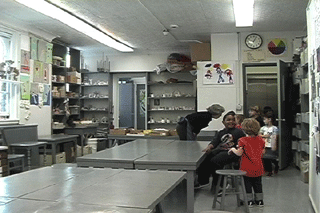 Class begins, 9:04 a.m.: movie clip [18 sec./1.6 MB] Class begins, 9:04 a.m.: movie clip [18 sec./1.6 MB] |
"Come in!" "Yes, texture, you remembered what we talked about last week!" "Show me that you know how to get ready for art." "What do you call those things you used that were rough and smooth and bumpy? Yes, texture, you're going to be using textures again today." |
|
Nancy invites the children to explore materials "The five- and six-year-olds get into figurative work by doing stick puppets. The puppets themselves are made of flat brown corrugated cardboard that has been precut into large and small rectangles. There are head sizes, body sizes, and leg sizes: a square head, a large rectangle for the body, and four skinny rectangles for the arms and legs." |
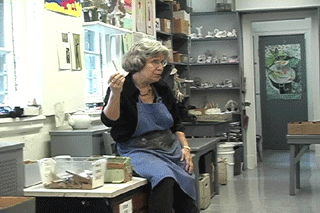
Nancy explains materials, 9:05 a.m.: movie clip [34 sec/3.2MB]
|
"I want to see how you can take something from this box, and I'd like to see how you could take four of these, and show me if you can make a person or an animal." "When you finish your person or animal you may come down here, and you're going to find some things that are . . . soft, fluffy, or leather, . . . How could you dress your person with some of these shapes, for example?" |
|
Nancy asks the children to demonstrate for each other how to make a person or an animal "To get the children started, I'll toss some of these pieces onto the table and ask the child how he or she might put them together. By moving the rectangles around, he or she finds a way. . .If I say 'how,' I'm honestly saying to them, 'How do you want to do it? How do you want to do it? And, How can you do it?' And they say, 'I can do it this way.' I say, 'Great! That's fine. That's a good way to do it.'" |
|
"How can you make a person or an animal?" "Show me how you could put those shapes together to make a person." "Now, you started this with something very important. You began actually by putting the head like this: overlapping it. And overlapping is a good idea." |
|
Children are sent to find their materials and begin working on their puppets. |
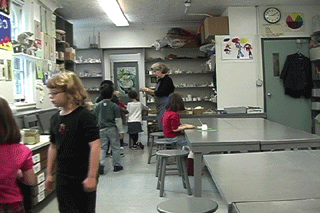 Children get their materials, 9:10 a.m.: movie clip [13 sec/1.3 MB] Children get their materials, 9:10 a.m.: movie clip [13 sec/1.3 MB] |
"Okay, how about everybody who's sitting over at this table so quietly, you get the pieces you'll need for your puppets. Why don't the people at this table get their glue." |
|
| ovie clip | |||
Nancy encourages and helps the children as they work "Making stick puppets is the foundation for working with people and animals in drawing and painting. There's a real transfer of this knowledge of simple basic shapes to make people and animals, when they're ready to do figuration. I think it really feeds that ability. And if kids can make people and animals, they can talk about their lives, because their lives are filled with people and animals." |
Nancy: (to K) "That looks to me, like a person." K: "It is!" N: "Is that what you want to make?" K: "Yeah" N: "Alright, how are you going to put some glue, to make it stick together?" K: "A little dot." |
||
| m | |||
Once children have finished gluing their cardboard animals and people together, Nancy invites them to the collage table to find pieces of yarn, felt, feathers, furs, fabrics, beads and buttons to add to their creations. "By the time they've put a little hair on a rectangle and added two little beads or a button or whatever, they have created a face. The children sometimes ask about drawing or painting the face, but I say, 'How can you do it with collage? Because that's what we're working with today.'" |
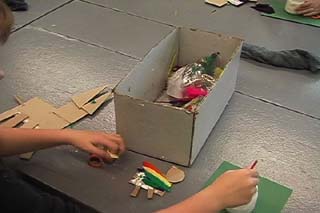 Nancy helps a child transition into decorating her puppet, 9:16 a.m.: movie clip[36 sec/2 MB] Nancy helps a child transition into decorating her puppet, 9:16 a.m.: movie clip[36 sec/2 MB] |
N: "I knew you could make a little turkey! Want to put little baby feathers on it?" S: "How?" N: "Little baby feathers. . ."[leads child to supply area where feathers are stored] |
|
Nancy asks specific questions about the decisions the children are making. She guides those who are having trouble making decisions, and contributes to a dialogue with all of the children in the room as they go through the process of making their puppets. |
|
"How could you dress your person with some of these shapes, for example?" "You want to make a mane with cardboard or with fur?" "You could even put some of the shiny papers on top. Would you like to put those on or would you like to put something like this?" "Do you want fur, or do you want felt?" |
|
| Nancy takes notice of children's work and describes to the young artists what she sees. "This is direct feedback: the pleasure and joy of creating something right there, that they have in mind, not that I have in mind. That I'm not pushing them to, but that they really can kind of find on their own. I mean, one kid making a unicorn, another kid making a power plane, or a fancy lady. This is the variety that these simple materials can support." |
|
"Look at those two guys; they're like brothers." "Oh, my goodness, this is the unicorn, right? I want to say something about this tail, I think the tail is just so special and beautiful." "Look at that wondrous little animal you did. You're a hard worker with quite an imagination. Look at the gold sparkle you added." |
|
Children's Finished Stick Puppets |
|||
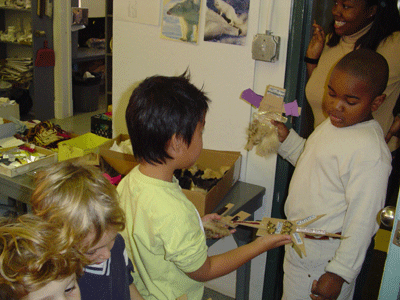 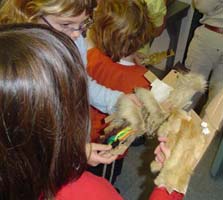 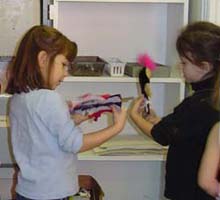 |
|||